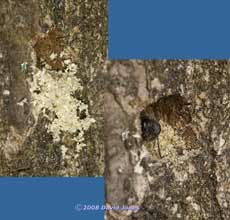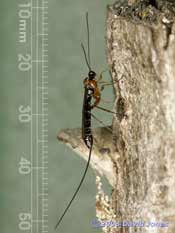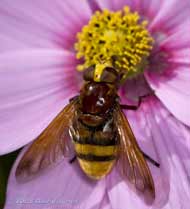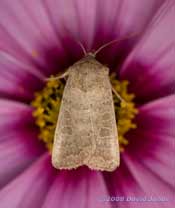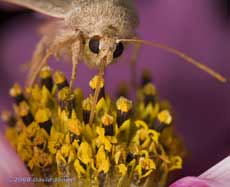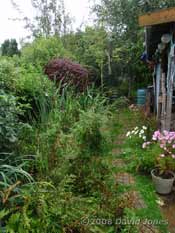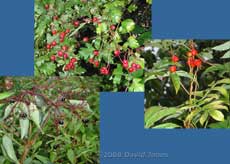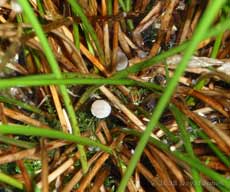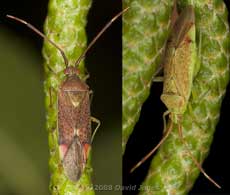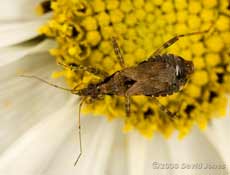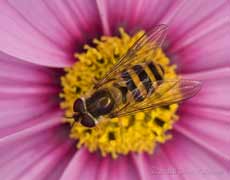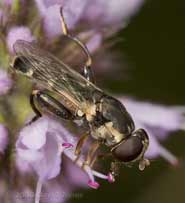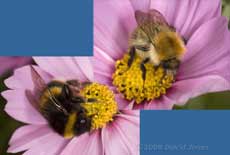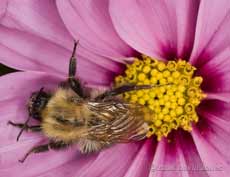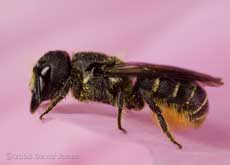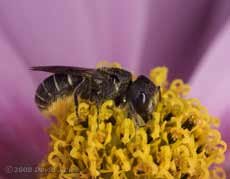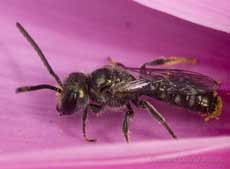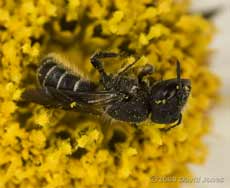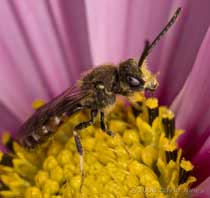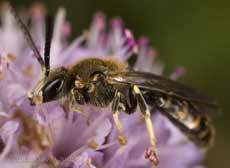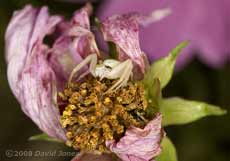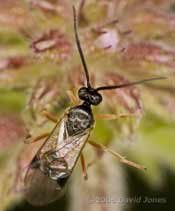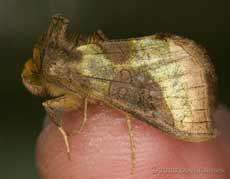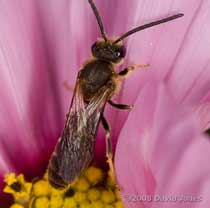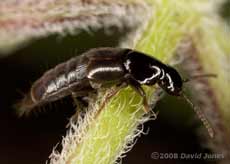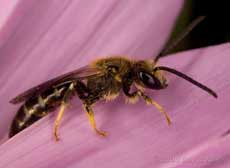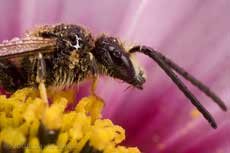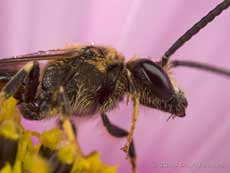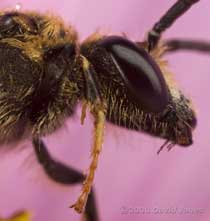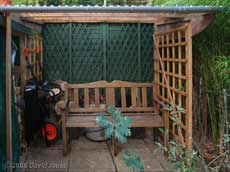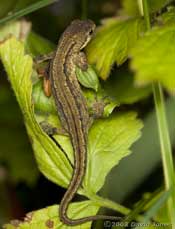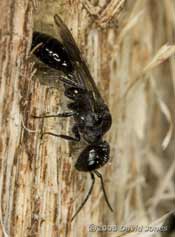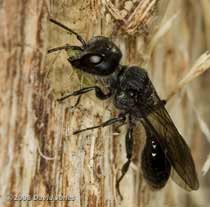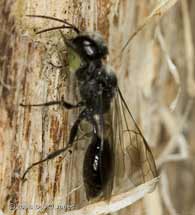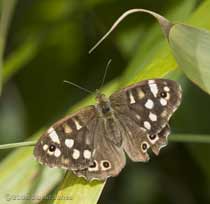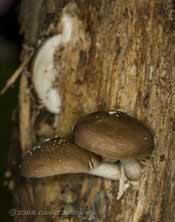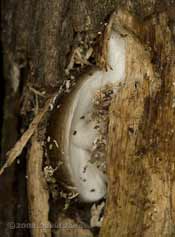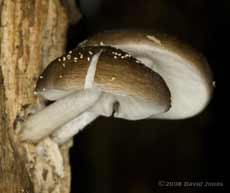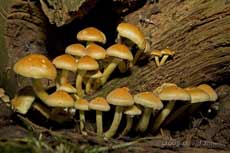Go to the last entry on this page .....Go to previous entry2 September - The first two days of the month have had a decidedly autumnal feel to them. Yesterday it was bright and sunny, but not particularly warm at around 16C. Today started off wet. It brightened up by the afternoon but a stiff breeze made it feel quite chilly at times. I resorted to socks and a warm top when I spent time out the garden! This morning I was sorting something out under the caravan shelter when I noticed what looked like dust fall from one of our bee-hotel logs. It seemed that something was busy extending a hole in the log. The left-hand image shows the wood chips that were pushed out at around 11.30am. I set up a tripod for the camera and settled down to photograph the inhabitant. After an hour and a half, and without a glimpse of the insect I had to give up as we needed to go out for a while. When I was able to resume the vigil at around 5pm it was obvious that work in the hole was continuing, only now the wood chips were darker and much smaller. The right-hand, blurred image was the nearest I got to photographing the insect responsible. I caught sight of another, all black insect entering a hole lower down on the log - I wonder if they are the same species? I've left the tripod in place to try again tomorrow morning.
Perhaps it was coincidence, or maybe the activity in the holes attracted this ichneumon fly which moved around the log, waving its antennae with particular enthusiasm each time it came across a hole. It stayed around for quite a while, although it didn't find anywhere suitable to insert its long ovipositor. My attempts to identify it haven't been successful tonight.
While I was waiting for the wasp(?) to appear, it was interesting to see how the ratio of bumblebees visiting the garden seems to be changing. Today I saw just one Garden Bumblebee, as opposed to several dozen Carder Bees.
There seemed to be very few hoverflies. There were more about during yesterday's sunshine, and there were quite a few visits by this female Volucella zonaria (Belted Hoverfly). While most of its visits were to the mint flower heads, this was the only time I saw it visit a Cosmos bloom. To give an idea of its size, the centre of the flower measures about 13mm across.
Tonight While the Cosmos flowers are popular with bees and hoverflies during the day, tonight has been the first time that I've seen a moth on one - I have just found what I thought was a Common Quaker (Orthosia cerasi) taking nectar on one. However, Tim Norriss has let me know that it is in fact a Vines Rustic (Hoplodrina ambigua) - the Common Quaker usually has only one generation in March-May.
Here you can see how it probes down inside the ring of tiny petals that surround each floret.
Turning to the bird in the garden - over the last few weeks things have been very quiet. We have only a small flock of House Sparrows at the moment, and Blackbirds are only occasional visitors. One day last week there were two Dunnocks under the Hawthorn for a short time but I haven't seen them since. Before our holiday there were two juvenile Robins making frequent visits. Now I just see a single Robin in adult plumage. While I was watching the bee hotel this morning I saw a House Martin, and possibly a second one flying over, so I guess there has been a late brood somewhere in the local area. This afternoon there must have been at least twenty Goldfinches around the feeders and the Hawthorn. Not only are the sunflowers being consumed rapidly but they have also started on the Thistle seeds again having ignored them through the summer. While Sheila and I had a meal outside, one Goldfinch juvenile decided that the feeders were too much like hard work and spent more than five minutes feeding on the ground, along with the Robin and some Sparrows! While the Blue and Great Tits usually feed at either the bird table or the Sunflower feeders, this afternoon I watched a Blue Tit picking seeds out of Nipplewort (Lapsana communis) seed heads. It seemed to have quite a tough time pecking the seeds open but kept going back for more, so it must have decided they were worth the effort!
9 September - Over the last week the thought of an 'Indian Summer' has retreated way into the realms of wishful thinking as the skies have remained largely grey, with the promise of rain never far away. For me it hasn't helped as I continue to combat my constant weariness. Today I'm been using a daylight lamp next to my computer - I'm beginning to think that I shouldn't have put it away for the summer this year! Yesterday the forecast promised some sunshine. It failed to materialise but at least it remained dry and a breeze made it the first good drying day for a week or more! Today started dry, but it didn't last, becoming wet in the afternoon. However, after not taking any photographs for a week I've managed to make up for lost time over these last two days.
The weather has not been kind to the garden. Heavy rain showers have tended to cause some plants to flop over. That, along with me not doing any trimming at the moment means that it is looking a bit straggly.
There are clear signs of Autumn around the garden. The Hawthorn berries are now bright red and next to it the Elder has its dark purple berries, although many of these have already disappeared. The Rowan has several small bunches of berries for the first time, and its leaves are starting to change colour. The Burberris bush has lots of berries, but the Pyracantha near the house has just a handful of orange berries despite having lots of flowers in the Spring.
The Ivy tree has flower buds now. However, after the drastic trimming that I gave it I don't expect many berries on it in the new year.
Fungi are only just making themselves visible in the garden this Autumn, and these small fruiting bodies are the largest to appear so far, tucked into the base of a clump of rushes (Hard Rush - Juncus inflexus, I believe).
Some of the leaves on the Birch are starting so show signs of mildew development, which should be good news for the Orange Ladybirds, although besides the larvae that I reported on at the end of August I have seen only one or two this last week, with just two pupae seen, and no adults. The ends of some of the branches on the Birch have over-wintering catkins on them and last night I found that a couple of them were the roosts for these Mirid bugs. Despite the variation in colour, I think that they are the same species, although I have yet to identify them - thanks to Philippe Moniotte for suggesting that the species is Pantilius tunicatus, a bug found not only on Birch but also Alder and Hazel. Tonight I found eight of them in exactly the same circumstances.
I think that it may be an Ant Damsel Bug (Himacerus mirmicoides). Even if that ID is incorrect it is a first for the garden. There was no sign of it on the Cosmos tonight.
There are far fewer hoverflies about at the moment, and over the last two days, the only ones that I've seen visiting repeatedly have been Syrphus ribesii (seen more yesterday that over the previous couple of weeks),
and this one that I'm having trouble identifying tonight. This species seems only interested in the Water Mint. Thanks again to Philippe who suggests that it is probably Syritta pipiens.
Despite the miserable weather the Common Carder and Garden Bumblebees continue to visit.
However, even they can be caught out by the weather. I found this Carder Bee stretched out on the Cosmos flower this morning. The flower was facing east and I assume that it was trying to absorb a bit of solar energy. Despite the cloud it must have been somewhat successful as eventually it started moving about before feeding and flying away.
The solitary bees also found it necessary to stop for long periods. Like the Carder Bee, this little bee spent over two hours on a petal. You can see that the pollen brush under its abdomen is almost clear of pollen grains. This individual also had only one antenna.
Later, I found what I assume to be the same bee feeding on the same flower. I'm certain that it is Heriades truncorum (sometimes refered to as the Daisy Carpenter Bee). The species has been far less active this year, perhaps reflecting another poor year for the Ragworts.
On another Cosmos flower was another solitary bee which remained stationary for even longer. Its longer antennae, lack of pollen comb and different abdominal details suggest that it is a different species.
While those bees spent just a part of the day 'doing nothing' on a flower, this bee spent all of last night on a flower. Completely torpid when I took this picture at just before 10pm. It was still in this state at 9am this morning but had flown by 10am.
I photographed two other examples of solitary bee yesterday. This first one has quite distinctive red markings on its abdomen. It could be Lasioglossum calceatum (Slender Mining Bee), although I'm confused as to whether it would the the male or the female. It seems that the amount of red varies between the sexes, but I haven't been able to decide which sex this one is
The second one, which I only see visiting the Water Mint, is very similar but lacks the bold red banding - could I have been looking at the male and female of the same species?
As long as the bees and hoverflies keep on visiting, the crab spiders are still hopeful for a meal. However, this individual remained on the same Cosmos flower even as it withered away, not moving to another bloom until the shrivelled petals were falling off.
While trying to photograph that last bee (it was moving about too quickly!) I managed to grab a couple of pictures of this small ichneumon fly as it hunted around flower buds. Was it searching for moth eggs?
And finally, just one moth. I'm afraid that I haven't been watching out for moths over the last week, but I had to take notice of this one when it appeared in the house. While its head has a bright orange 'plumage', its wings have an impressive metallic sheen and it wasn't a surprise to identify it as a Burnished Brass (Diachrysia chrysitis). While it is a common moth, it is another first for me.
10 September - A mixed sort of a day. It started off quite bright but turned wet for a while, improving again in the late afternoon.
I didn't spend much time with the camera today, although I did get another chance to photograph the hoverfly with thin orange bands on its abdomen that I recorded yesterday (L. calceatum). This time I had just enough time to get this one shot of it as it prepared to leave a Cosmos flower.
There was very little activity around the few Water Mint flowers still open, and I had to look below a flower head to spot this rove beetle (similar to a Devil's Coach-horse).
12 September - A grey start to the day, but I'm hoping that it will stay dry so that I can complete a task I started yesterday. With dry weather promised (and delivered!), I spent much of yesterday dismantling a 'temporary' wood store that I put up on the West Wing last year so that I can replace it with a more permanent structure. I completed most of the framework by the end of the day, and the roof should be on by this evening.
Doing that work meant that I didn't take any photographs during the day, but I did record another example of a solitary bee spending last night on a Cosmos flower (photographs taken at 10pm). This time it was a L. calceatum.
At 10am this morning it was still there, now tucked up against the centre of the flower and covered with dew, a drop of water combining with the ringflash to give the impression of a large, simple eye.
By 10.45am, while it wasn't sunny a breeze was well on the way to drying the bee and it was starting to become more active. This close-up taken then shows the eye clear of water droplets,
and a close look at the front leg reveals a spur on the tibia.
The Cosmos plants are starting to look a bit sorry for themselves now - I guess that their season is coming to an end. While I was at work yesterday the garden was visited twice by a Sparrowhawk which caused chaos amongst the birds that were here. There were Sparrows diving into any small space they could find and a Collared Dove left a dusty impression on our patio window. I found that bird looking as though it might have broken its wing. However, I decided to leave it along for a while and sure enough after some twenty minutes or so it flew off again, hopefully fully recovered. An update at 3.30pm - I've been forced indoors by an unexpected thunderstorm, complete with hail, and with the skies a dark grey all around us I may call a halt to the work out in the garden. The roof panels are cut to size, and I'd just put them in place to start fixing them when the rain started. At least it gave me a chance to stand underneath and think about how to utilise the water that runs off it. There isn't room for another water butt, so I'll be using guttering to direct the water towards the line of bamboos at the side of the West Wing.
14 September - After a dry and bright day yesterday, it looks as though we are in for another one today. And it will be a day of rest after I more or less completed the log store yesterday. There are a few bits and pieces to be fiddled with, but it's ready for use, and in the meantime we can still use it as a place to sit and watch the garden. The original, and much smaller log store is just visible at the left of the photograph.
I did that for a short while in the afternoon while clearing up and saw a puzzling bit of behaviour. Some Long-tailed Tits arrived in the garden (I could hear them more than see them). Then, all of a sudden, one of them flies into the Birch, being chased by a Collared Dove. There was no doubt about the chase as they moved in a loop between the lower branches of the tree. Why on earth would a Collared Dove want to chase a Long-tailed Tit? Talking of Collared Doves, yesterday, one spent much of the day down on the ground in the garden. Although it seemed to be ok, moving freely, stretching its wings and feeding, I'm wondering if it is the bird that flew into the window. There was no sign of it at the end of the day, and I cannot see it this morning, so I assume that eventually it did fly away. There was no sign of the Sparrowhawk during the day. I've largely ignored the pond this year, but it's not possible to ignore the frogs. Either they appear as you move a stone, log or flower pot, or you hear their croaking from all corners of the garden. That certainly was the case as I worked on the log store these last few days.
However, while the frogs let you know of their presence, the newts, whilst also active in the garden, remain silent and secretive, and about the only time you get to spot them is when their hunting takes them up into the foliage. This individual was photographed at around 10pm last night on the slope up to the West Wing as it moved very slowly between leaves.
As usual, there were also were a couple of hedgehogs hunting here last night, one was a large adult and the other, less than half its size. They do not react well to being disturbed, so I rarely take photographs of them at night. I know that I was 'distracted' by the log store yesterday, but I don't think there were many bumblebees about, despite the brighter conditions.
15 September - The summer weather continues! The morning was spent 'on the road' and then this afternoon I spent a couple of hours on the first stage of an experiment that will continue once we start using our wood burning stove this winter. We have decided to find out whether it will be worth making our own paper/card 'briquettes' to supplement the wood that we burn. over the last couple of weeks we have started turning newspapers and packaging into papier-mâché and using a metal press to turn them into briquettes. So far, so good - all we need now is for this good drying weather to continue! Making the briquettes this afternoon was a slow process, not because it was difficult, but because I'm somewhat shattered by the log store construction (my tree surgeon son came for a meal yesterday afternoon and brought some oak logs to start filling it!). During one of my frequent pauses I was thankful to a spider web for distracting me. It wasn't the web itself that caught my eye, but the fine, and fresh 'sawdust' that covered it. The web was directly below the log where I had tried, unsuccessfully to photograph a solitary wasp back on the 2nd (top of this page).
It was soon very clear that there were three wasps active in the afternoon sunshine, so I washed away the papier-mâché from my hands, set up my camera and kept my fingers crossed - which I didn't need to do for long as a wasp emerged form a hole which measures about 7mm across. I estimate that the wasp is almost 12mm long.
For this wasp the digging phase was complete, and over the next hour I watched as it made sorties to collect aphids. During that time I saw it return ten times, although some of the time was spent with it resting just inside the entrance, usually when the sun had disappeared behind a cloud.
In photographic situations like this I have to try to predict how the insect will approach (or leave) the burrow and preset the focusing - the depth of field is so shallow, and the insect moves so fast that auto focus is useless. It can work well if the insect uses the same route each time, but in this case the wasp wasn't particularly obliging and many shots were completely out of focus. However, It's always worth keeping those shots just in case there is something useful somewhere in the frame, and that was the case with this next picture.
While the body of the wasp, and the aphid are hopelessly blurred, I had caught the wasp just before it folded its wings, and the wing venation enabled me to decide that the species is Pemphredon lugubris. It is also known as the Mournful Wasp because of its all-black colour. I read that it uses small beetle holes in dead wood that has lost its bark. When it has finished supplying a supply of paralysed aphids, it will lay an egg and then cap the hole with mud - perhaps tomorrow.
While I sat watching the wasps I was treated to a close encounter with a Speckled Wood which landed on the side of the log and spread its wings flat to soak up some sunshine. I couldn't photograph it then, but I had captured this picture of the same individual earlier in the day as it sunbathed on a bamboo leaf.
Turning back to wasps, over the last few days I've started seeing social wasps hunting in the garden, after being largely absent throughout the summer.
17 September - A fairly bright day with periods of hazy sunshine - an improvement on yesterday when we had grey skies apart for a minute or two of sunshine around breakfast time. There hasn't been any rain over these two days. Just a couple of items for this entry. Back on the 9th I mentioned the appearance of just a couple of small fungi. Over the last couple of days two of our decaying logs have yielded much larger gilled fungi (neither of which I'm going to attempt to identify tonight).
This first picture shows three fruiting bodies on a log at the bottom end of the garden. Two of the bodies have completely emerged from the decaying wood,
while the third has opened up while still half embedded.
The caps have a slightly hairy appearance.
The second fungus is growing in and in the ground around the base of a log near the house. As you can see, unlike the first fungus it has produced a large number of fruiting bodies.
There is now going to be another one of those gaps in my diary - hopefully to be filled soon! Click on images to see larger versions |
|
